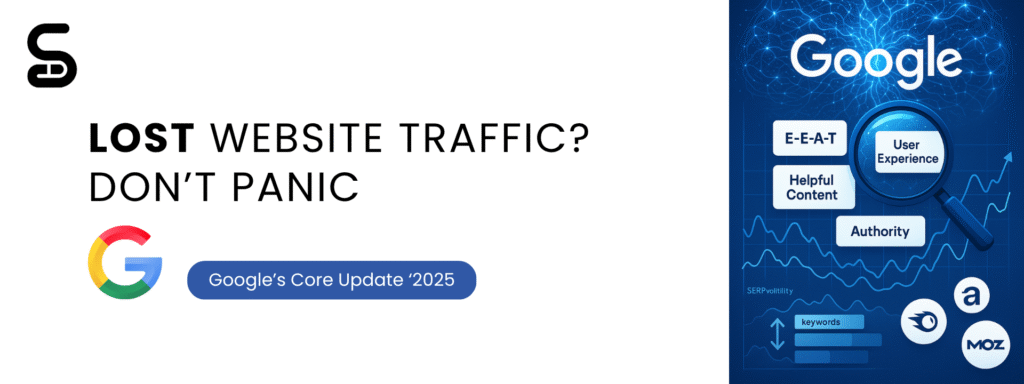Google Core Update June 2025: What It Means for Your Digital Marketing Strategy
Introduction Google’s June 2025 Core Update is more than just an algorithmic refresh — it’s a wake-up call for brands and marketers to refocus on authenticity, helpfulness, and user experience. If you’re a marketing leader, startup founder, or digital strategist, understanding this update isn’t optional — it’s essential to safeguarding and scaling your online visibility. In this blog, we break down: What changed in the update How it impacts your rankings and content What research from Google, Semrush, Ahrefs, and Moz reveals Actionable steps to future-proof your digital marketing strategy TL;DR: It’s time to align your content with real people, not just search engines. What Is the Google Core Update (June 2025)? Core updates are large-scale improvements to Google’s ranking systems, aiming to present better, more helpful content to users. According to Google Search Central, the June 2025 update rolled out between June 30 and July 17, introducing refinements across: Content quality evaluation Intent-matching algorithms Trust signals based on E-E-A-T Overall user experience and SERP relevance It builds upon Google’s Helpful Content System, which prioritizes content created by people, for people — not for clicks or rankings alone. (source) Key Focus Areas of the Update 1. ✅ Elevating User Experience Google emphasized fast-loading, mobile-optimized pages, cleaner layouts, and content clarity. Websites that prioritize UI/UX saw improvements in visibility. 📈 Example: A healthcare client of Sordit Digital improved average position by 18 spots simply by decluttering mobile UX and improving readability on blog pages. 🔗 Google Page Experience Signals 2. ✅ E-E-A-T: Still the Cornerstone Google doubled down on Experience, Expertise, Authoritativeness, and Trustworthiness (E-E-A-T). According to Search Engine Journal, pages that provided real-world proof, expert bios, original research, and citations from reputable sources consistently outperformed generic or AI-spun content. 💡 What helps your E-E-A-T? Add author bylines with credentials Showcase reviews, testimonials, and case studies Use citations and links to established sources Secure your site with HTTPS and clear contact info 3. ✅ Depth Over Breadth: Content Quality > Content Quantity The update reprioritized comprehensive, insight-driven content over short or keyword-stuffed articles. This aligns with ongoing research from Ahrefs, which shows that longer, more useful pages tend to earn backlinks and rank for more keywords. 📊 Semrush’s data from July 2025 revealed that websites with topically clustered content saw up to 22% more stable rankings during and after the update. (Semrush Sensor) Impact on the SERPs: Winners vs. Losers Based on data from MozCast and Ahrefs, here’s how rankings shifted: Winners Losers Expert-written blog content with author schema AI-generated content without human editing Product pages with unique descriptions, reviews & FAQs Thin affiliate pages Local service websites with complete Google Business Profiles Generic directories with outdated info What This Means for Long-Term Digital Marketing Strategy The Google Core Update June 2025 should be a turning point for your digital roadmap. Here’s what it means practically: 🔍 Revisit Your Content Strategy Move beyond SEO checklists. Focus on content that solves real problems, adds value, and reflects your brand’s true expertise. “If you’re creating content primarily to rank in search engines, you’re doing it wrong.” – Google Helpful Content Guidelines 💡 Invest in Content That Proves Experience From how-to guides written by your internal experts to case studies, video walkthroughs, and user-generated testimonials, prioritize content that shows your real-world knowledge. 🔗 Google’s Quality Rater Guidelines (2023) 🧭 Adopt a Search Intent–First Model Use tools like Ahrefs, Semrush, and Google Search Console to map keyword queries to search intent: Informational (blog) Navigational (homepage/service) Transactional (product page) Local (GMB + landing) When your content answers user intent well, rankings follow naturally. Real-World Example: Recovery through Relevance A fintech client of Sordit Digital saw a 30% traffic drop post-update. We ran a quick recovery plan: Audited 400+ blog posts for freshness and expertise Consolidated duplicate content into in-depth guides Added certified financial expert bios to all articles Improved load speed by 1.2 seconds on mobile 📈 Result: Within 6 weeks, their top 10 keyword positions improved by 41%, with steady new leads via organic traffic. What You Can Do Today (Action Checklist) ✅ Audit your top 30 pages for: Author bios Updated stats and references Internal linking Search intent alignment ✅ Use Google Search Console to monitor traffic dips post-June 30 ✅ Create a content calendar focusing on quality and originality ✅ Refresh old posts that haven’t been updated in 18+ months ✅ Build trust signals: reviews, About Us page, case studies, media mentions Final Thoughts The Google Core Update June 2025 is clear in its message: Value real content, real experience, and real trust. Whether you’re a startup, an enterprise brand, or an agency — it’s time to think beyond keyword tricks. It’s time to think strategically about digital marketing that delivers human value. Need Help Navigating Google’s Algorithm Updates? At Sordit Digital, we specialize in helping businesses adapt to Google’s evolving standards. From content audits and E-E-A-T strategies to SERP recovery and long-term SEO planning, our team is ready to help you grow organically and sustainably. 👉 Let’s talk: Schedule a free consultation 📞 Or reach us on WhatsApp | 🌐 www.sorditdigital.com



